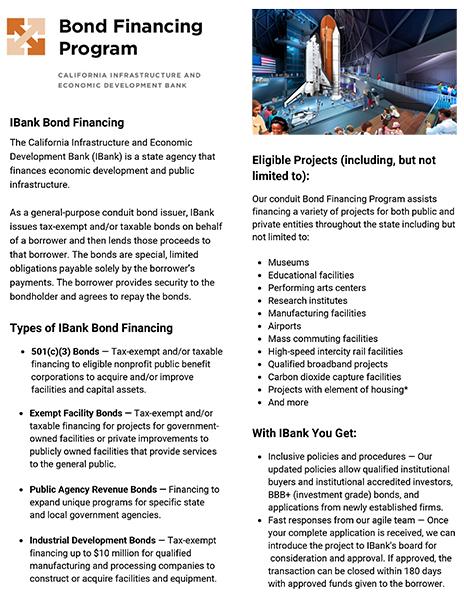 Industrial Development Bonds and Manufacturing Bonds
Industrial Development Bonds and Manufacturing Bonds
Government agencies issue bonds to finance a variety of economic or public development projects for private and public entities. When investors purchase bonds, they essentially lend money to the borrower through the issuer. In return for the bond proceeds, the borrower promises to pay the investors/bondholders the principal amount plus a specified rate of interest over the life of the bonds based on the bonds debt service payment schedule. In this way, a bond is similar to a complex loan.
Municipal Bonds
Bonds issued by government entities are called municipal bonds. The proceeds of the bonds are used to finance projects that benefit the community such as roads, schools, bridges, sewers, parks, water treatment or for qualified projects of private entities. Most bonds issued by government entities are tax-exempt. This means interest on these bonds is excluded from gross income for federal tax purposes. In addition, interest on the bonds is exempt from state of California personal income taxes. IBank issued bonds, including federally taxable bonds, will be exempt from the state of California personal income taxes.
What is a conduit bond issuer?
As a conduit issuer, IBank does not underwrite bonds. IBank issues bonds on behalf of a borrower and then lends those proceeds to that borrower. The bonds are special, limited obligations payable solely by the borrower’s payments. The borrower provides security to the bondholder and agrees to repay the bonds.
Industrial Development Bonds (IDBs)
Tax-exempt financing up to $10 million for qualified manufacturing and processing companies for the construction or acquisition of facilities and equipment. IDBs allow private companies to borrow at low interest rates normally reserved for state and local governmental entities.
Eligible IDBs Applicants
Industrial Development Bonds (IDBs) are tax-exempt securities issued up to $10 million by a government agency to provide money for the acquisition, construction, rehabilitation and equipping of manufacturing and processing facilities for private companies.
Projects
The project financed by the bonds must be a facility used for manufacturing, production or processing of tangible or intangible property (including the processing resulting in the change of such property). No more than 25 percent of the bond proceeds can be applied to an ancillary office, warehouse, or other space. Certain other private activity bond rules apply to IDBs.
Public Benefits
The project financed by the bonds must meet certain public benefit criteria established by the IRS, which include, among other things, the creation or retention of jobs. All IDBs need a volume cap allocation before tax-exempt bonds can be issued for them. IDB applicants will need to submit a separate application to the California Debt Limit Allocation Commission (CDLAC) in order to apply for tax-exempt allocation. The CDLAC meeting schedule and application due dates can be found under Meeting Agendas, Schedule and Materials.
The IDB Process
The IDB financing process can generally be completed within 120-150 days. The IBank staff and financing team, which typically consists of an underwriter, bond counsel, and financial/municipal advisor, will assist the applicant through each stage of the process.
Manufacturing Bonds
Other Financing Options
Due to the relatively higher cost of bond financing, applicants of manufacturing projects up to $10 million, may visit U.S. Small Business Administration (SBA) for 504 Loans, or review IBank’s Small Business Finance Center (SBFC) Loan Guarantee Program to learn about the applicable terms and conditions of these Programs. IBank’s Loan Match Portal can connect you directly to the right Participating Lenders.
Examples of IBank Issued Bonds
IBank issues bonds for a variety of projects throughout the state including museums, educational facilities and performing arts centers, research institutes, charitable organizations, energy-efficiency projects for healthcare facilities, manufacturing facilities, and more. Some of the manufacturing projects that have been financed with the help of IBank-issued bonds, include projects for Alegacy Foodservice, MA Silva Corks USA, LLC, Applied Aerospace Structures, Superior Lithographic, Prinsco Inc., Betts Spring Company, All Sato Kreis Holding, LLC, Solar Atmospheres, KAKS-Hydrosystems, Bay Photos, and Canyon Plastics, and Capital Corrugated. Check out some of the projects that have been financed with IBank issued bonds.
Examples of IBank Issued Bonds
IBank issues bonds for a variety of projects throughout the state including museums, educational facilities and performing arts centers, research institutes, charitable organizations, energy-efficiency projects for healthcare facilities, manufacturing facilities, and more. Some of the manufacturing projects that have been financed with the help of IBank-issued bonds, include projects for Alegacy Foodservice, MA Silva Corks USA, LLC, Applied Aerospace Structures, Superior Lithographic, Prinsco Inc., Betts Spring Company, All Sato Kreis Holding, LLC, Solar Atmospheres, KAKS-Hydrosystems, Bay Photos, and Canyon Plastics, and Capital Corrugated. Check out some of the projects that have been financed with IBank issued bonds.
Frequently Asked Questions and Fact Sheet
IBank Issued Bonds
Q: Is there an aggregate limitation on IDBs?
A: A borrower and certain users may not be the beneficiary of more than $40 million of certain tax-exempt bonds regardless of the location of the projects, during a three year period after the facility being financed is placed in service.
Q: What are considered eligible IDB costs?
A: At least 95% of the bond proceeds must be spent on qualifying costs, generally capital expenditures such as land, building and equipment and other depreciable property (and can also include capitalized interest during construction). Land: No more than 25% of the proceeds can be used to acquire land.
Q: What is the maturity for an IDB?
A: The average maturity of the bonds cannot exceed 120% of the average economic life of the assets financed.
Q: Is there a limit to the amount of capital expenditures that can be spent on an IDB project?
A: Yes, total capital expenditures for the project (the aggregate face amount of the issue plus the aggregate amount of capital expenditures) in the same public jurisdiction where the project is located cannot exceed $20 million during the six-year period beginning three years before the date of the IDB issuance and ending three years thereafter.
Q: What is the credit requirement for IDBs?
A: The borrower needs to secure a letter of credit in the amount of the bonds from a bank with a long-term credit rating of at least “A3” from Moody’s Investors Service, or an “A-” from Standard & Poor or Fitch Ratings, Inc. Bonds can also be sold directly to Qualified Institutional Buyers or Accredited Investors, without a rating, as long as IBank conditions for direct Purchases or private Placements are met. For details, please refer to IBank Policies and Procedures for Conduit Bonds.
Q: Can the acquisition of existing manufacturing facilities be financed with an IDB?
A: The acquisition of existing facility (including manufacturing equipment) can be financed if at least 15% of the portion of the bond amount used to purchase the facility is spent on eligible rehabilitation of expenditures within a two-year period. The machineries purchased with the IDBs proceeds must be brand new.
Q: Can IDB proceeds be used to finance working capital or inventory?
A: No.
Contact the IBank Bond Unit
Bond Finance Program Manager: Fariba Khoie
E-mail us, HERE
Office: 1325 J Street, Suite 1300, Sacramento, CA 95814
Contact the IBank Bond Unit
Bond Finance Program Manager: Fariba Khoie
E-mail us, HERE
Office: 1325 J Street, Suite 1300, Sacramento, CA 95814

















































